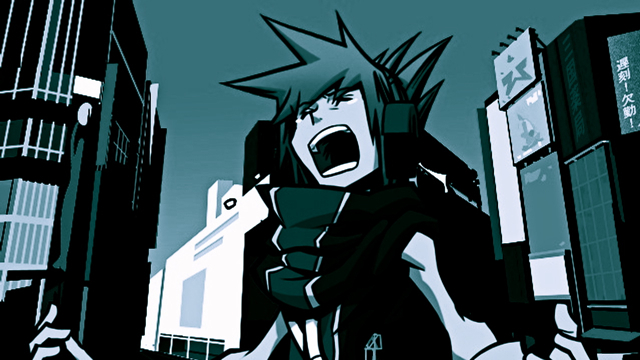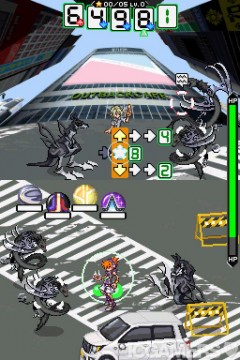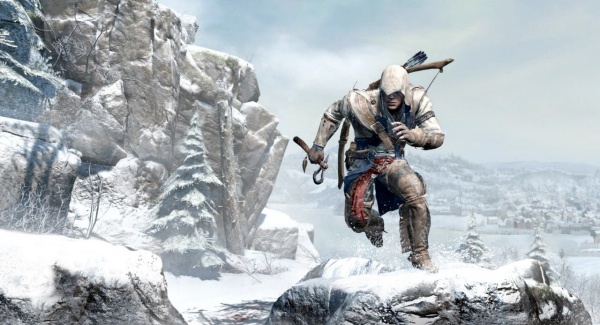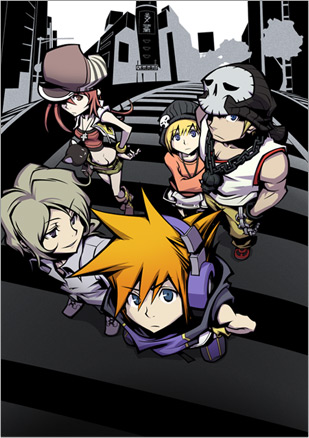
About a month ago, I finally got my hands on a copy of Square Enix’s highly acclaimed JRPG, The World Ends with You. Originally released back in 2008 on DS, we absolutely adored this game when it came out, and it’s without doubt one of the most innovative and upbeat JRPGs I’ve played in a while. I loved everything from its modern J-Pop soundtrack to its crazy take on Shibuya adolescence and the afterlife, but there was so much more going on beneath the surface that it was almost impossible to keep track of it all. From the minute-by-minute fashion trends affecting the strength of your psychic pin powers to the minutiae of your daily digestive tract, The World Ends with You proved that JRPGs can still be as hip and cool as the rest of Video Game Land. To say I’m almost a little ashamed that it slipped under my radar for so long would be putting it mildly.
For me though one of the most fascinating things about The World Ends with You was its unique battle system. Every time Neku and his partner encountered the Noise of Shibuya, they were separated into the top and bottom screens of the DS (or two different planes of existence as the game liked to call them). But rather than each character having their own respective HP bars like most other JRPGs, they both shared the same life meter, meaning players had to juggle using the stylus and the much maligned d-pad to control both characters simultaneously in order to get through each battle. It took some getting used to, and I’m still not sure I understand it completely, but each fight took on a life of its own once you mastered the necessary hand gymnastics.
At the same time, however, I kept noticing that my attention was drifting more and more to the bottom screen. There I was, merrily flicking and tapping my stylus and generally kicking ass with Neku’s touch-controlled pins while my partner was left to the ravages of the Noise in the screen above. I was winning each battle within an inch of my life (and sometimes failing altogether), and my battle score never ranked higher than an E for several hours. Thankfully, the game does give you some leeway and will take over your partner’s movements automatically if you leave them idle for too long, but I wanted the challenge of trying to control them myself. I just wasn’t very good at it.
For a while I thought about why this was happening. Maybe it was because Neku was the main character and therefore I was subconsciously drawn to concentrate on him more than his partner. Perhaps it was because I was right handed, making the stylus the more dominant method of control, but in the end I came to the conclusion that I just couldn’t concentrate on both screens at the same time.
 You see, while each of Neku’s partners have their own attack system, they’re all based on the same basic control scheme– if your enemies are on the left, hit the left d-pad; if they’re on the right, hit the right d-pad. It sounds simple enough, and is certainly enough to get you though most encounters, but if you want to improve your battle technique (and thereby get more pin EXP and better rewards) it becomes a lot more complicated.
You see, while each of Neku’s partners have their own attack system, they’re all based on the same basic control scheme– if your enemies are on the left, hit the left d-pad; if they’re on the right, hit the right d-pad. It sounds simple enough, and is certainly enough to get you though most encounters, but if you want to improve your battle technique (and thereby get more pin EXP and better rewards) it becomes a lot more complicated.
Take Joshua on the right, for example. His chain attacks are based on the row of numbers at the top of the screen, and each card has a little arrow on it telling you whether to aim higher or lower than the set number. In this case, simply hammering right will score you an 8, and ordinarily that would be absolutely fine. Joshua will still attack and cause damage, but it will also break the chance of a chain attack as that little green arrow above is telling you your ideal score should be a number less than 8. Therefore you really want to hit the 4 or the 2, but this means actively looking up at your available options, taking your attention away the bottom screen, and then trying to press the appropriate buttons without getting slammed in the process. Throw in jumps, dodges, trying to mitigate fall damage and keeping an eye on Neku into the mix and it can all get a little overwhelming.
It’s not impossible by any means, and I gradually learnt to cope with its myriad controls the more I played, but I became increasingly concerned about what this might mean for Nintendo’s highly anticipated Wii U. We all know that Wii U will also have two screens at its disposal, one on the TV and the other built right into the controller, but will it present the same kind of concentration problem as The World Ends with You? After all, if I can’t cope with two screens sitting almost right next to each other, how am I going to cope with two screens at opposite ends of the room?
Of course, a large part of this will depend on what kind of information developers choose to put on Wii U’s controller screen. As we’ve previously reported at Nintendojo, the upcoming Assassin’s Creed III will use Wii U’s controller for a variety of different functions. Not only will it act as a portal into the Animus Database, but it will also feature an on-screen map, an encyclopaedia, and allow you quicker access to your arsenal of weapons. The controller’s accelerometer will also let you control the camera angle in Eagle Vision, an Assassin technique which lets them see an alternative view of their surroundings.

All these features probably won’t require the same kind of mental acrobatics as The World Ends with You— Animus entries will only pop up every now and again and have been promised not to interrupt the flow of the game, and the character biographies will be there to read at your leisure. As for switching your weapons on the fly, this could get a little hairy in the heat of battle, but if done right (perhaps in the vein of Street Fighter IV: 3D Edition‘s touchscreen attack prompts) it’s unlikely to cause players much grief.
It’s also been said that Darksiders II, one of Wii U’s launch titles, is also going to use Wii U’s controller for seamless weapon changing. Likewise, the “HD Experience” demo we saw at last year’s E3 suggested that future Zelda games might also use the controller in a similar fashion, taking a leaf out of Ocarina of Time 3D‘s book with touch-activated item selection and on-screen maps.
In fact, several DS and 3DS games could point the way towards a stress-free Wii U controller experience, and it seems like Ninja Gaiden III: Razor’s Edge, another Wii U launch title, is already well aware of this fact. Even back at last year’s E3, developers Tecmo Koei were saying how they were planning to borrow from the control scheme of Ninja Gaiden’s DS entry, Dragon Sword, for the Wii U version of Razor’s Edge. In Dragon Sword, all of Ryu’s movements, jumps and attacks are controlled via the touchscreen (much like the DS Zelda games), and if Wii U’s E3 trailer was anything to go by, we could well be throwing proper shurikens in Razor’s Edge too.
 Yet I’m sensing a bit of a trend with these controller features. Clear away the map, chuck in some quick item management and Miyamoto’s your uncle. It’s not exactly…well, very exciting, is it? Don’t get me wrong, losing the tedious menu interface in Ocarina of Time 3D and being able to equip your Iron Boots at the touch of a button was an absolute godsend, but is this all Wii U’s controller is going to boil down to? A mere fine-tuning of established mechanics and an extension of what DS and 3DS have already achieved, rather than a real game-changer?
Yet I’m sensing a bit of a trend with these controller features. Clear away the map, chuck in some quick item management and Miyamoto’s your uncle. It’s not exactly…well, very exciting, is it? Don’t get me wrong, losing the tedious menu interface in Ocarina of Time 3D and being able to equip your Iron Boots at the touch of a button was an absolute godsend, but is this all Wii U’s controller is going to boil down to? A mere fine-tuning of established mechanics and an extension of what DS and 3DS have already achieved, rather than a real game-changer?
Of course, neither Assassin’s Creed III, Darksiders II or Ninja Gaiden III: Razor’s Edge are first-party Nintendo titles; they’re all third-party multi-platform games being developed for other consoles as well– and we know from experience that Nintendo always manage to get the best out of their hardware– so until we see how they’re going to step up to the plate, perhaps I’m being overly hasty in my scepticism. Nevertheless, part of what made The World Ends with You so exciting was how it used the DS in such a new and interesting way. It demanded your attention (no matter how schizophrenic it was) and ramped up the tension like no other JRPG out there, turn-based or otherwise, and was infinitely more captivating than simply tapping in a ream of menu commands like so many other RPGs on DS. It may have been hard– and perhaps ever so slightly flawed in its complexity– but I felt like I was achieving something when my E grade slowly worked its way up to an A.
Perhaps I’m a glutton for punishment, but I’d really like to see more ambitious games like The World Ends with You succeed on Wii U and push its hardware further than what’s been currently announced. Wii U’s controller has so much potential just waiting to be unlocked (as well as the chance to make all the dreams of the GCN-GBA cable come true), and part of me thinks it would be a real shame if it was sidelined to mere tidying-up duty all the time. Naturally, balancing a player’s attention between the two screens will always be tricky, and having not seen Wii U in action for myself, it’s a little hard to judge just how much of an issue concentrating on two screens so far apart will actually be. But for what it’s worth, I think Video Game Land would be a much better place if it had more games like The World Ends with You.




 ShareThis
ShareThis







Nicely done. I’ve also yet to try this game, but this has given some added incentive to seek it out.
I am really curious to see what Nintendo does with their technology: they really do develop projects for their own interests in a sort of “lead-by-example” system. While third parties often come up short, I like that they give them a ton of freedom to explore the tech’s potential. Here’s hoping they use it.